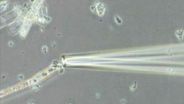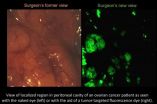Low-fat yogurt intake when pregnant may lead to child asthma and hay fever
2011-09-19
(Press-News.org) Amsterdam, The Netherlands: Eating low-fat yoghurt whilst pregnant can increase the risk of your child developing asthma and allergic rhinitis (hay fever), according to recent findings.
The study will be presented at the European Respiratory Society's (ERS) Annual Congress in Amsterdam on 25 September 2011. All the abstracts for the ERS Congress will be publicly available online from today (17 September 2011).
The study aimed to assess whether fatty acids found in dairy products could protect against the development of allergic diseases in children.
The researchers assessed milk and dairy intake during pregnancy and monitored the prevalence of asthma and allergic rhinitis using registries and questionnaires in the Danish National Birth Cohort.
The results showed that milk intake during pregnancy was not associated with increased risk of developing asthma and it actually protected against asthma development. However, women who ate low-fat yoghurt with fruit once a day were 1.6-times more likely to have children who developed asthma by age 7, compared with children of women who reported no intake. They were also more likely to have allergic rhinitis and to display current asthma symptoms.
The researchers suggest that non-fat related nutrient components in the yoghurt may play a part in increasing this risk. They are also looking at the possibility that low-fat yoghurt intake may serve as a marker for other dietary and lifestyle factors.
Ekaterina Maslova, lead author from the Harvard School of Public Health, who has been working with data at the Centre for Fetal Programming at Statens Serum Institut, said: "This is the first study of its kind to link low-fat yoghurt intake during pregnancy with an increased risk of asthma and hay fever in children. This could be due to a number of reasons and we will further investigate whether this is linked to certain nutrients or whether people who ate yoghurt regularly had similar lifestyle and dietary patterns which could explain the increased risk of asthma."
INFORMATION: END
ELSE PRESS RELEASES FROM THIS DATE:
2011-09-19
The crystal structure of the dynamin protein — one of the molecular machines that makes cells work — has been revealed, bringing insights into a class of molecules with a wide influence on health and disease.
"It's a really cool structure," said Jodi Nunnari, professor and chair of molecular and cellular biology at UC Davis and senior author of the paper, to be published Sept. 18 in the journal Nature. "This is a really important class of molecules for regulating membrane dynamics."
The detailed structure reveals exactly how the dynamin protein can form large assemblies ...
2011-09-19
SAN DIEGO, CA and PHILADELPHIA, PA – September 18, 2011 —Tarsa Therapeutics today presented positive safety and efficacy data from its Phase III ORACAL trial of OSTORA™, the company's oral recombinant salmon calcitonin tablet in development for the treatment of postmenopausal osteoporosis. These data were presented at the American Society for Bone and Mineral Research 2011 Annual Meeting by ORACAL investigator Neil Binkley, MD, who is an Associate Professor of Endocrinology and Geriatrics at the University of Wisconsin School of Medicine and Public Health in Madison, ...
2011-09-19
VIDEO:
Receptors on the cell's surface crowd around the nanotube, effectively standing it upright. The cell mistakes the tube for a sphere and begins to engulf it.
Click here for more information.
PROVIDENCE, R.I. [Brown University] — It's been long known that asbestos spells trouble for human cells. Scientists have seen cells stabbed with spiky, long asbestos fibers, and the image is gory: Part of the fiber is protruding from the cell, like a quivering arrow that's found ...
2011-09-19
Researchers have developed a new method to sequence and analyze the dark matter of life—the genomes of thousands of bacteria species previously beyond scientists' reach, from microorganisms that produce antibiotics and biofuels to microbes living in the human body.
Scientists from UC San Diego, the J. Craig Venter Institute and Illumina Inc., published their findings in the Sept. 18 online issue of the journal Nature Biotechnology. The breakthrough will enable researchers to assemble virtually complete genomes from DNA extracted from a single bacterial cell. By contrast, ...
2011-09-19
BOULDER -- The planet's deep oceans at times may absorb enough heat to flatten the rate of global warming for periods of as long as a decade even in the midst of longer-term warming, according to a new analysis led by the National Center for Atmospheric Research (NCAR).
The study, based on computer simulations of global climate, points to ocean layers deeper than 1,000 feet (300 meters) as the main location of the "missing heat" during periods such as the past decade when global air temperatures showed little trend. The findings also suggest that several more intervals ...
2011-09-19
WEST LAFAYETTE, Ind. - The first fluorescence-guided surgery on an ovarian cancer patient was performed using a cancer cell "homing device" and imaging agent created by a Purdue University researcher.
The surgery was one of 10 performed as part of the first phase of a clinical trial to evaluate a new technology to aid surgeons in the removal of malignant tissue from ovarian cancer patients. The method illuminates cancer cells to help surgeons identify and remove smaller tumors that could otherwise be missed.
Philip Low, the Ralph C. Corely Distinguished Professor of ...
2011-09-19
Scientists at the University of Plymouth have shown, for the first time in an animal, that nanoparticles have a detrimental effect on the brain and other parts of the central nervous system.
They subjected rainbow trout to titanium oxide nanoparticles which are widely used as a whitening agent in many products including paints, some personal care products, and with applications being considered for the food industry. They found that the particles caused vacuoles (holes) to form in parts of the brain and for nerve cells in the brain to die. Although some effects of nanoparticles ...
2011-09-19
Production of crop milk, a secretion from the crops of parent birds, is rare among birds and, apart from pigeons, is only found in flamingos and male emperor penguins. Essential for the growth and development of the young pigeon squab, pigeon 'milk' is produced by both parents from fluid-filled cells lining the crop that are rich in fat and protein. Research published in BioMed Central's open access journal BMC Genomics uses new technology to study the genes and proteins involved in pigeon 'milk' production and shows that pigeon 'milk' contains antioxidants and immune-enhancing ...
2011-09-19
Researchers whose findings on the detrimental impact of some common medicines on elderly people were widely reported earlier in the summer have found that taking a few of these medicines does not appear to cause further cognitive impairment in those already suffering from dementia.
In a paper published today by the journal Age and Ageing, Dr Chris Fox of the University of East Anglia (UEA) and colleagues from a number of other universities and the NHS describe how they studied a clinically representative sample of 224 people with established Alzheimer's dementia who ...
2011-09-19
ITHACA, N.Y. – With an eye toward understanding DNA replication, Cornell researchers have learned how a helicase enzyme works to actually unzip the two strands of DNA. (Nature, online Sept. 18, 2011.)
At the heart of many metabolic processes, including DNA replication, are enzymes called helicases. Acting like motors, these proteins travel along one side of double-stranded DNA, prompting the strands to "zip" apart.
What had been a mystery was the exact mechanics of this vital biological process – how individual helicase subunits coordinate and physically cause the unzipping ...
LAST 30 PRESS RELEASES:
[Press-News.org] Low-fat yogurt intake when pregnant may lead to child asthma and hay fever



